
The Audio Reflex AGS-150 receiver is an interesting piece of audio equipment. It was designed and manufactured by AGS Electronics Limited for Audio Reflex and introduced in 1976. While not well known, it has an intriguing look and some unique features. Audio Reflex was a Canadian audio brand that got bought out by the Korean company Inkel back in the early 1980s. AGS gear at the time was manufactured in Japan and known for being pretty high quality.
Design
The AGS-150 receiver looks like a product of the AGS marketing department on steroids. They obviously took a number of iconic elements from other popular receivers and mixed them into the design of the AGS-150. Some call it the ‘love child of a Yamaha and a Marantz’ or a Yamarantz.

It has cursive script on the front panel, similar to a Marantz, but with a lot more of it and in a font that is difficult to read. Even the tuning dial is in cursive. The model description on the front panel is excessive. The top reads:
Solid State AM/FM Stereo Amplifier / Pre Amplifier Model AGS 150
The script that is almost unreadable under the Audio Reflex badge I believe says:
IC – Dual Gate MOS FET
Not sure why that had to be put on the front panel other than for marketing.
They also borrowed the Marantz gyro touch tuning wheel design. The switch knobs are extremely similar to Yamaha’s CR receiver series. The dial lighting and meters, as well as the use of sliders on a built in equalizer, are similar to Fisher receivers.
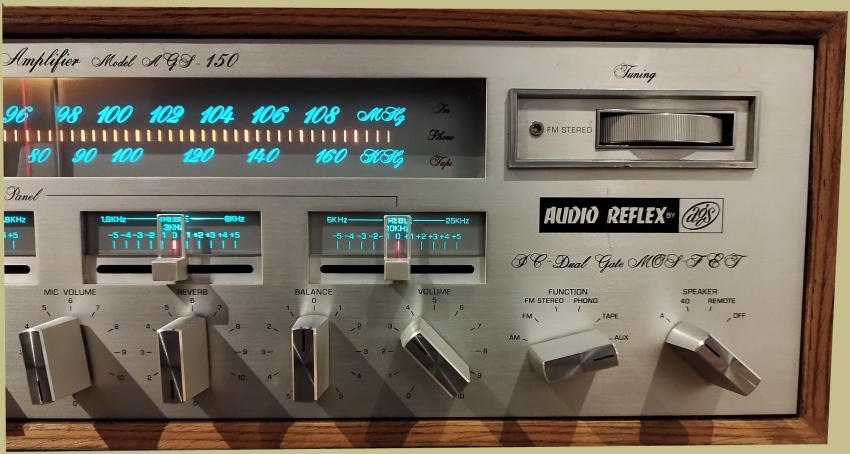
Front Panel
The AGS-150 Receiver provides a front jack for stereo headphones. There is also an input jack and gain control for a microphone, enabling you to mix the microphone audio with another signal source. There are a plethora of controls including Multiplex Filter, AF Control, FM Muting, Mono/Stereo Mode, Low and High filters, and a Loudness Contour.
The receiver has two meters on the left side, one for signal strength and another for tuning accuracy. This tuning meter is centered at zero and lets you know when you’ve hit the optimum tuning point for best sound quality.
The AGS-150 has five slider-type tone controls so that you can fine tune the audio output to suit your preferences. The center-neutral setting of each control is clearly indicated, allowing for precise adjustments. With these controls you can tailor the sound to your liking. Each of the five tone controls provides around 10 dB of boost or cut at the center frequency marked on the knob. The center frequencies are 80 Hz, 300 Hz, 1 kHz, 3 kHz, and 10 kHz.
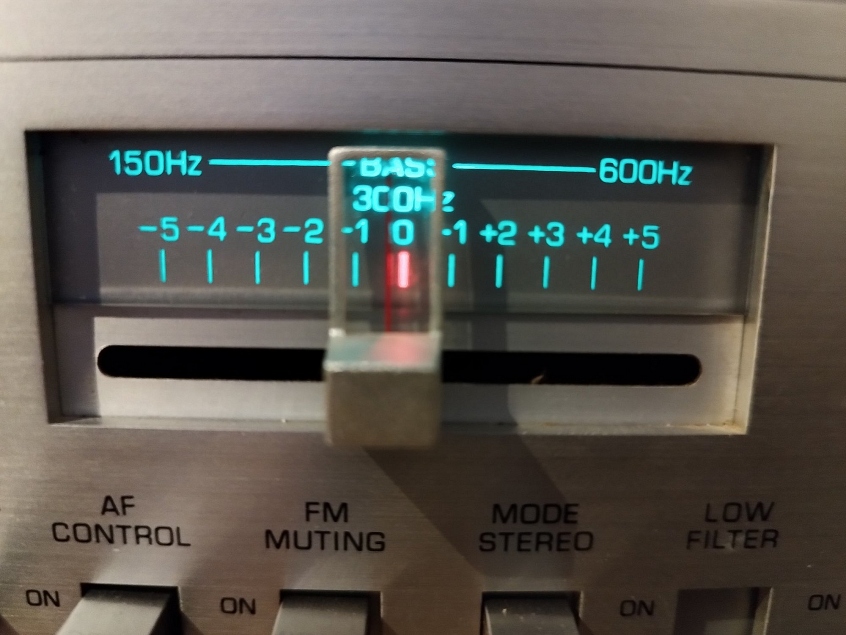
One interesting feature of the Audio Reflex AGS-150 is its built in reverberation capability. Each channel is equipped with a transducer type, spring-operated reverb unit, allowing you to add a touch of ambiance to your audio playback. The intensity of the reverb effect is adjustable through a front panel control, giving you complete control over the sound. Not useful to an audiophile, and a bit of a gimmick, but a cool talking point.
The 4D setting on the speaker selector switch lets you add a rear pair of speakers to the front pair of speakers, like an early surround sound setup only that the output signal to all the speakers is the same.
Specifications
Power: 50 + 50 W 8 ohms.
Harmonic distortion: 0.25% at 35 W; 0.4% at 50 W both at 1 kHz.
Power bandwidth: 30 Hz-50 kHz.
Frequency response: 20 Hz-20 kHz + 1 dB.
Loudness: 8 dB 50 Hz.
Inputs:
aux 150 mV;
tape 150 mV;
disc 2.6 mV;
mic 4 mV;
tape mon 280 mV.
Reverb – time: 2.6 sec. at 1 kHz.
Sensitivity: 1.9 uV FM ( IHF usable)
Harmonic distortion FM: <0.4% (m): <1.2% (s) at 400 Hz.
Image rejection: >50 dB FM: >54 dB AM.
FM capture ratio: 2.2 dB.
IF rejection AM at 1 MHz: >45 dB.
AGS obviously made receivers for other retailers as well. This Sears Model 28747 receiver is an exact replica of the AGS-150 with the exception of the Sears logo. Interestingly the Sears RE-1801 (AGS-152), which is a 100 watt model, doesn’t have the script lettering.

Here is the cool Sears logo on the 28474. And, it’s from their Professional Series so it must be good!
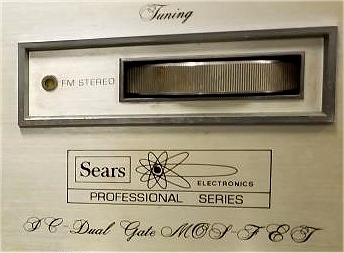
The cabinet on the AGS-150 is nice. Somewhat low profile like a Yamaha. Not sure if it’s wood or vinyl though.
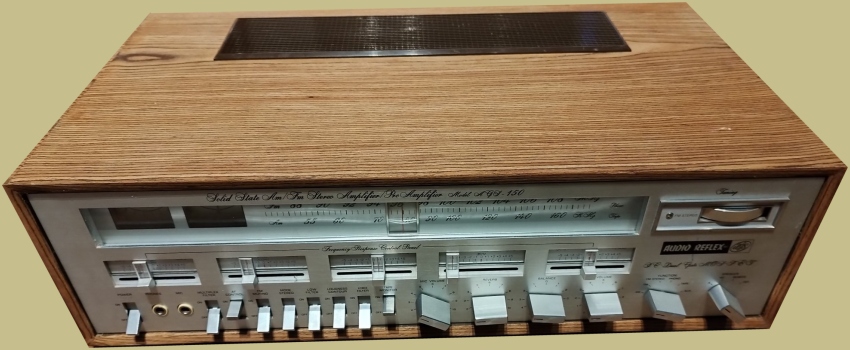
FM Tuner
The FM front end of the AGS-150 receiver has a simple design, with just two tuned circuits between the antenna and the mixer stage. A third tuned circuit is used for the local oscillator section. The radio frequency (RF) amplifier stages utilize a dual gate field effect transistor (FET), which provides decent intermodulation performance despite the simple front end.
The intermediate frequency (IF) section uses a combination of LC bandpass filters and ceramic filters. This results in good alternate channel selectivity, which is the ability to reject signals from adjacent channels. The filters also have minimal asymmetry, meaning signals are rejected evenly on both sides of the desired frequency.
Given the relatively straightforward front-end circuitry, the overall performance of the FM receiver is respectable. It can provide good reception under both long-distance and local signal conditions.
Amplifier
The Audio Reflex AGS-150 produces 50 watts per channel into 8 ohms. The amplifier seems fairly well designed and utilizes a fully complementary design with capacitive coupling to the loudspeakers. The interior of the receiver is well laid out and appears easy to service. You can see the spring reverb unit in the middle (gold and black rectangular box).
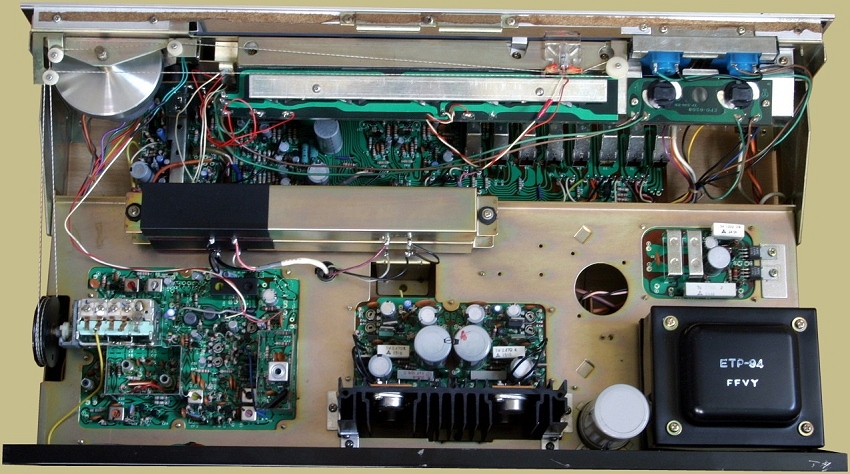
Rear Panel
The AGs-150 has a range of input options allowing you to connect multiple audio sources. It offers an Aux input so you can connect a device like an iPod or CD player, a phono input for a turntable, and tape inputs. There are two AC outlets, one switched and one un-switched. It also has terminals for three sets of speakers with the option for bare wire or banana plug connections. You can see the connections for the 4D rear speakers here as well.

The Audio Reflex AGS-150 is an intriguing receiver. It takes all of the marketing hype of the mid 1970’s audio world and combines it into one neat receiver package. While the specs aren’t bad, it’s overall performance is underwhelming. Nonetheless, I can’t say that if I saw one at a reasonable price I wouldn’t buy it. It wouldn’t be for its performance though, it would just be for its audacious look.
Interesting to see a review on this receiver. I own the previous version of this model with a dial for the FM tuning. Bought it in 1978 at a local CB radio electronics store in Niagara Falls, NY. I still have it it good working condition. Good FM reception and loud output from the AMP section. A great buy at the time for a 20 yr old. I still love it.
I still have my AGS 150, purchased in 1976 in the UK. Works perfectly, its been in storage for a year now and replaced with a Onkyo as that one has a remote to switch inputs and volume. Got a dodgy knee so cant get up and down as quick. I also have the original user and service manuals
Selling possibly?
I bought mine from a trade show that came to town. A friend bought one at the same time. We have the model 150 without the script lettering. More recently, mine went through a major house fire, but may be useful for parts. The power switch burned up on my friend’s unit. He brought it to me to “repair”, but won’t tell me if he’s giving it to me or if he really wants it repaired. (I’m a former tv / vcr repairman). He just grins every time I ask.
I’m always watching for a nice clean one to replace my damaged one, but only if the cost is reasonable. I did get one from eBay a few years ago. It’s in nice shape, but I really think I should have another two or three! I’d even travel a few states away to avoid the hassles of packing and shipping. I’m in north central Wisconsin.